Vancouver 125
The City of Vancouver is 125 years old this year!
There are over 450 historic places listed on the Canadian Register
of Historic Places for Vancouver, so you could visit at least one a
day throughout the year and still not see them
all! Vancouver is a city with a distinctive urban fabric, and
its skyline always seems to be changing. This dynamism is
reflected in the surprising number of vibrant heritage buildings
and landscapes. 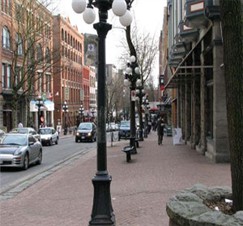
The historic heart of Vancouver is located in
Gastown. This interesting and historic area - officially
recognized as Gastown Historic District National
Historic Site (NHS) - can be found near Burrard Inlet just
east of the current downtown skyline, and is dominated by
commercial buildings constructed between 1886 and 1914. These
buildings exhibit a wide variety of architectural styles, the most
common being Romanesque Revival and Victorian Italianate. Of
the 147 buildings here, 141 were built before 1914, and most of
these are in exceptionally good condition. Within the
boundaries of the historic district are many attractions, such as a
steam clock, a large bronze statue of "Gassy" Jack 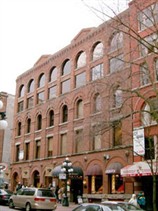 Deighton, and Maple Tree
Square, the city's first public square. And of course, there
are some prominent buildings here, including the attractive Byrnes Block (Victorian Italianate, 1886), the
massive Hudson's Bay Company Warehouse (Romanesque
Revival, 1894), and the unusual Europe Hotel (Neo-Classical Flatiron,
1908). For almost a century, Gastown was the commercial heart
of Vancouver, with numerous department stores operating here, as
well as many hotels due to the area's proximity to the terminus of
the transcontinental railway and steamship docks. Forty years ago,
in 1971, the area was one of the first places in Canada to be
recognized for its heritage value as a cultural landscape. Since
then, Gastown has become a prime attraction for tourists who wander
its cobblestone streets and attend festivals such as the Vancouver
International Jazz
Deighton, and Maple Tree
Square, the city's first public square. And of course, there
are some prominent buildings here, including the attractive Byrnes Block (Victorian Italianate, 1886), the
massive Hudson's Bay Company Warehouse (Romanesque
Revival, 1894), and the unusual Europe Hotel (Neo-Classical Flatiron,
1908). For almost a century, Gastown was the commercial heart
of Vancouver, with numerous department stores operating here, as
well as many hotels due to the area's proximity to the terminus of
the transcontinental railway and steamship docks. Forty years ago,
in 1971, the area was one of the first places in Canada to be
recognized for its heritage value as a cultural landscape. Since
then, Gastown has become a prime attraction for tourists who wander
its cobblestone streets and attend festivals such as the Vancouver
International Jazz 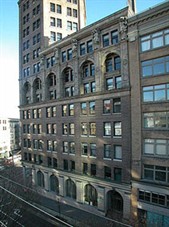 Festival.
Festival.
Not far outside the boundaries of the historic district is the
Sun Tower, which was the tallest building in
the British Empire at the time of its completion in
1912. Designed by architect William Tuff Whiteway, the
building is seventeen storeys high, and has a Beaux-Arts dome and
cupola which sit atop a nine storey polygonal tower. Though
it was commissioned to house The World newspaper, it is
better known as the home of The Vancouver Sun, which took
occupation of the building in 1937, and immediately installed an
illuminated globe on the building's exterior, adding to its already
iconic status. Though the newspaper moved out in 1964, the
idea of news being made here seems seared into the cultural
consciousness of the city, and so the building still retains the
newspaper's name and remains a major downtown landmark.
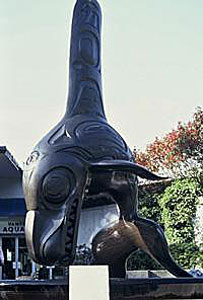 For those of you who want a break from
the urban hubbub, you can escape to nearby Stanley Park NHS, a forested
recreational area located on a peninsula just north and west of
downtown. Originally used as a First Nations ceremonial site,
the citizens of the city have long made use of the park's natural
beauty, and have created many diversions to pass the time
here. So though you could merely walk through the ancient
forests or rollerblade on the path following the seawall at the
park's edge, you could also visit the aquarium, hop on a miniature
train, spend some time at the children's zoo, play cricket at the
cricket pitch or bowl on the lawn bowling green, and go for a swim
at one of the outdoor pools. You can also get superlative
views of the north shore mountains here, as well as Vancouver
Harbour and iconic Lion's Gate Bridge.
For those of you who want a break from
the urban hubbub, you can escape to nearby Stanley Park NHS, a forested
recreational area located on a peninsula just north and west of
downtown. Originally used as a First Nations ceremonial site,
the citizens of the city have long made use of the park's natural
beauty, and have created many diversions to pass the time
here. So though you could merely walk through the ancient
forests or rollerblade on the path following the seawall at the
park's edge, you could also visit the aquarium, hop on a miniature
train, spend some time at the children's zoo, play cricket at the
cricket pitch or bowl on the lawn bowling green, and go for a swim
at one of the outdoor pools. You can also get superlative
views of the north shore mountains here, as well as Vancouver
Harbour and iconic Lion's Gate Bridge.
First set aside in 1888, and landscaped between 1913 and 1936,
the park is an extraordinary place where you can lose
yourself in stands of dense and original west coast rainforest, or
you can meet many other people in highly designed landscapes filled
with imported trees, manicured lawns and statues. This
historic park has had contributions from many architects and
landscapers from each era, thus adapting the natural area to suit
the needs of contemporary society. As Vancouver changes and
evolves, so does the park. As a source of refreshment, this
oasis combines the best of what British Columbia is all
about: forests, mountains and ocean. It comes as no
surprise, then, that Vancouver chose Stanley Park as the focal
point of the 125th anniversary celebrations which
occured July 8-10th, 2011 and included many performances by
talented artists. 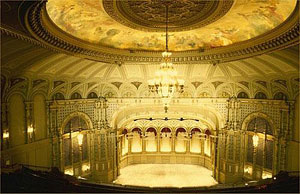
Speaking of performances, many of Vancouver's buildings are
associated with its significant artistic and cultural movements.
One such place is the Orpheum Theatre
NHS. Constructed in 1926, it was once
the largest and most extravagant movie theatre on the Pacific
Coast. Sometimes referred to as the "Grand Old Lady of
Granville," the theatre's luxurious interior includes a spacious
foyer, large seating capacity, and chandeliers made of
Czechoslovakian crystal. Originally intended as a venue for
showing films, the theatre has also accommodated symphonic
concerts and vaudeville acts. In fact, the theatre underwent
a major transformation during the 1970s, and it is now the city's
premier concert hall and the main performance space for the
Vancouver Symphony Orchestra. It is good to see such an
historic building being re-used in a way that helps it continue to
contribute to the cultural heritage of Vancouver.
Vancouver's heritage places are truly worth celebrating in the
125th year of the city's incorporation. It is
heartening to see that the celebrations have highlighted the
interconnections between arts, culture, the environment, and
architectural heritage. Historic places show us where the
city has come from, provide an important backdrop to its current
skyline, are integral to the life of the local community, and
provide clues as to how the city might shape its course in the
future.